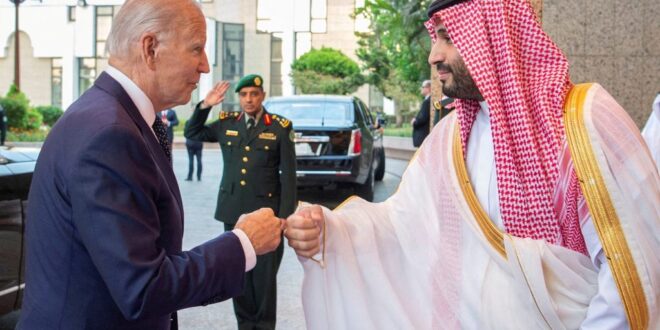Last Wednesday, somewhere over the Atlantic Ocean, US National Security Advisor Jake Sullivan informed reporters traveling with Joe Biden to the Middle East that the president would not be shaking hands during his trip. The stated reason was the recent uptick in COVID-19. But in reality, the White House—which less than forty-eight hours earlier had brought together a large crowd to celebrate the passage of new gun-control legislation—was spooked by the optics of shaking hands with Saudi Crown Prince Mohammed bin Salman (also known as MBS), the man accused of ordering the murder of Washington Post columnist Jamal Khashoggi.
At first, Biden held up well, declining to shake hands and instead fist bumping acting Israeli Prime Minister Yair Lapid, President Isaac Herzog, and other Israeli officials lined up along the welcome carpet (even as Secretary of State Antony Blinken amusingly followed right behind Biden, warmly embracing many of those same officials). But a no-handshake rule is a tough sell for any politician as gregarious as Biden, and in the end, he made it about five minutes before reverting to his preference for handshakes and warm embraces.
But more interesting is who received one of the first emphatic and affectionate handshakes: former Israeli Prime Minister (and current opposition leader) Benjamin Netanyahu, with whom Biden has shared a relationship for nearly four decades. The notoriously frosty relationship between Netanyahu and former President Barack Obama is well-known; when that relationship was at its lowest points, it was Biden who Obama dispatched to meet with Netanyahu to ensure the lines of communication remained open and that US messages were delivered.
The two were “frenemies” before the term ever existed. They were a pair of political heavyweights, ideologically out of sync but political kindred spirits who matured during a time of backslapping and backroom politics—when political differences were eclipsed by personal friendships. When Netanyahu lost the 1999 Israeli election to Ehud Barak, for instance, then Senator Biden was the only American politician to write to him. For politicians like Biden and Netanyahu, who rely on and even crave personal connection, such an act is not simply an extension of kindness, but a meaningful gesture whose impact is minimized by analysts at their own risk.
With Netanyahu seeking to return to the prime minister’s office, the handshake also reflected an eyes-wide-open potential reality: They might soon be working together again as equals. After the hostility of the Obama era and the overtly partisan embrace of the Trump era, their greeting on the tarmac—though brief—reflected a willingness to engage and work together, even if they don’t always agree.
A very Saudi salutation
By the time Biden arrived in Jeddah, he’d used up all known forms of hand gesticulation in Israel: fist bumps, handshakes, clasping hands, hands on shoulders, and hugs. In the end, the only form not seen was a behind-the-back high five.
Still, in Jeddah, Biden was inevitably going to revert to a fist bump. The president and MBS greeted each other with a clear preference for not having to greet each other. Symbolically, it pleased no one on the US side: Critics from human-rights organizations were enraged that Biden could share such a “bro-like” greeting with the man who ordered Khashoggi’s murder. Those supporting closer US-Saudi relations rolled their eyes in recognition that MBS would almost certainly take this as a personal slight.
Because symbols matter in international diplomacy, MBS—very likely aware that Biden would not offer a more conventional, formal greeting—pre-retaliated. He personally greeted all the other participants at the summit of the Gulf Coordination Council plus three nearby nations (GCC+3) at the airport but declined to greet Biden there, instead sending the governor of Mecca and the Saudi ambassador to the United States to stand in for him. That decision wasn’t so much a slight as a reflection of the current nature of the relationship. It’s unclear whether MBS originally planned to greet Biden at the airport; but once the president’s team announced that he would not be shaking hands, any chance of MBS going to the airport for just a knuckle-on-knuckle greeting evaporated.
Biden and MBS are never going to be personally close, and hostilities will linger. But the president didn’t go to Saudi Arabia in search of a best friend—he went to fundamentally reset and improve the relationship to a functional level, recognizing the benefits associated with strong US-Saudi ties. Unlike Emirati President Mohammed bin Zayed, who was invited by Biden to come to Washington, MBS won’t be a guest at Blair House anytime soon.
But next time they meet, you’ll be able to tell immediately whether the relationship has improved. A handshake, a fist bump, or a lowly wave hello will tell you all you need to know.
 Eurasia Press & News
Eurasia Press & News


